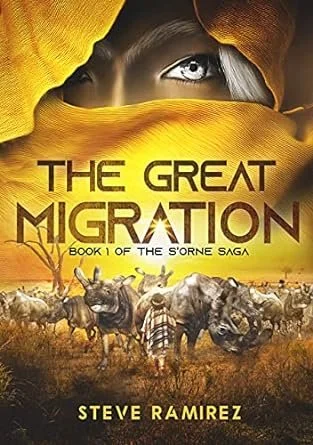SPSFC 3 Author Interview - Steve Ramirez
1. What inspired the world, characters, or core concepts of your story? Was it a particular event, piece of media, or a speculative scientific idea?
If I’m being honest, I started writing because I was livid at how the final season of Game of Thrones ended. I think I was tired of always being a consumer of the stories offered and decided to start creating them. Once I had made that decision, I leaned heavily on the book Guns, Germs, and Steel by Jared Diamond for my world-building. That book changed how I understood modern human society and helped me design an isolated country/continent like the one in the Great Migration. That book is why the themes of resource availability/scarcity are prevalent throughout my series.
2. How did you approach the creation of your main characters? Were they modeled after real-life figures, or did they evolve organically as you explored the world of your story?
I wrote the first chapter over thirty times, mainly because I was trying to figure out which character would have the most interesting arc through the course of a trilogy. Once I focused on Bellona, her backstory developed organically in my mind, which helped me write her character forward. I created the other main character, Dorinda, because I thought the story needed a villainous presence. It’s funny saying that because she became the readers’ favorite for the first book. I had to explain and justify her extreme behavior as the story went on, which made her character more relatable. She shines pretty brightly through the climax of the story, too.
3. Science fiction often delves into questions of ethics, technology, and humanity. What central theme or moral question does your story grapple with, and why did you feel it was essential to explore?
I like the quote by Arthur C. Clarke, “Any sufficiently advanced technology is indistinguishable from magic.” In my book, the primary setting’s technology is based largely on the Renaissance Period, but this level of scientific insight is insufficient to explain what is happening throughout the storyline. This allowed me to inject a great deal of fear into Bellona’s character, to the point that she refuses to believe her eyes when the truth is staring her in the face. Ultimately, she must reassess something she has always perceived as evil.
4. How did you approach the integration of futuristic technology or scientific concepts in your story? Did you base them on existing theories or let your imagination run wild?
I spent a summer studying the theory of general relativity to increase my familiarity with concepts like time dilation. I also looked at the popular views of quantum mechanics, the ideas of a multiverse, and the future of quantum computing. I think it’s safe to say that I took great pains to stay true to the concepts of general relativity in the story and let my imagination run wild with the themes of the multiverse and quantum computing.
5. The sci-fi genre provides a canvas to depict diverse cultures, species, and worlds. How have you incorporated representation and diversity in your work, and why do you think it's vital for the future of science fiction?
With a setting based on a remote continent, where humans had to sail for months by ship to get there, I gave myself a nice opportunity to create a world where the people living in it take the diversity of their society for granted, to the point it’s a non-issue. Furthermore, most of the society in the story has turned its back on formalized religion. This allowed me to do away with traditionalisms like moralities attached to nudity, sex and drug use, gender roles, and formal sexual identities/orientations. I think the science fiction genre has always been a forward-thinking environment. It’s constantly asking, “what if?” I would say that’s its lifeblood, and it’s the reason I feel honored to be a small part of it.
6. Every author has a unique writing process. Can you share a bit about yours? How do you manage world-building, plot progression, and character dynamics in such a complex genre?
I tend to overwrite, so I created a lot of characters and storylines and filtered them through my beta readers. Eventually, I deleted around 140 pages of the ideas that weren’t working and kept the ones that were. Once I hit that point, the book was finished in five weeks. I had the story's climax in my mind the entire time I was developing the characters, so when everything goes crazy toward the end, it was easy for me to set each character in motion in a manner consistent with who they were.
7. What's next for you after SPSFC? Are there any upcoming projects you can share with us?
This month (September 2023), I’ll be releasing the final two books of this trilogy, so I’ll be busy with each launch for the next few weeks. Beyond that, I look forward to expanding on the world I created and writing more stories around the concepts within the first book. It’s exciting for me to be a part of the SPSFC. One of my readers reached out to me through my website to encourage me to enter my book in this contest. Without her, I wouldn’t even be here, and I’m incredibly grateful to her for taking the time to push me forward.


